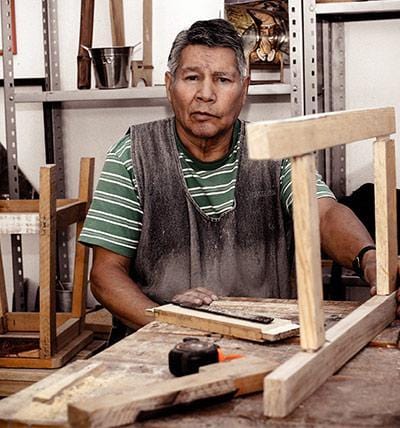When it comes to storing knives, there are a lot of options. Each has pros and cons, so think about who lives in your home and what your budget is like before choosing a storage solution.
Wall-mounted magnetic knife strips are common in restaurants, and they're stylish, sanitary, and convenient. However, you have to be careful when removing and replacing a knife, so you don't nick the blade.
Knife Storage Solutions Intro
While it’s important to care for your knives by sharpening them and washing them regularly, proper knife storage is also essential. Storing your knives correctly ensures they remain in tip-top shape and prevents accidental injuries to you and your family. There are a number of different ways to store your knives, depending on your kitchen space, lifestyle, and preferences. Taking into account all of these factors is essential when choosing the right knife storage method for you.
One popular option is under-cabinet knife storage. This is a safe way to keep your knives out of reach and free up counter space. This type of storage can be found in a variety of sizes, finishes, and designs.
Some even include magnetic strips that make a safer alternative to traditional block storage. If you choose to use a magnetic strip, be sure to place the blades of your knives with their dull backs against the magnet. Doing this lowers the risk of them chipping off a blade edge when you remove or replace a knife.

Knife Blocks: Traditional and Modern Options
For many cooks, a traditional knife block is the ideal storage solution. It will keep all your knives within arm’s reach and protect them from harm. These blocks typically come with a variety of fine-edged knives, and may also include scissors and a honing steel.
While a honing steel can help maintain a sharp blade, eventually it will be necessary to resharpen your knives.
If you’re considering a knife block, look for one that has slots designed for different knife sizes. These blocks will usually have either wood or plastic rods that will flex to fit all your different knife sizes. The design of the block will also influence how easily you can access your knives – some blocks require a straight vertical lift, while others have a diagonal slot opening that can make them easier to remove from the counter or cabinet.
Drawer inserts specially made for knife storage are another popular option. These inserts will allow you to store a full range of knife sizes, including larger chef’s and carving knives. They will provide protection for the blades from jostling and friction with other utensils, and they are easy to clean.
Magnetic Knife Strips: Efficient and Space-Saving
Magnetic strips, a popular kitchen knife storage method, are easy to access and can help you save counter space. They’re also a hygienic alternative to block storage because they allow for quick drying of knives between use, unlike the slots in a knife block where dampness can cause germs to grow.
Magnetic strip holders are available in different lengths to fit various knife sizes, and many come with mounting hardware, so you can install them on your wall. Some models of magnetic strip are also adhesive-backed, so you can stick them to your fridge or other metal surfaces.
The downside of magnetic strips is that they can place pressure on the tang of a full-tang knife when removed, which could compromise their structural integrity over time. They’re also not safe if you have small children in your home, and it’s essential to mount them high enough that they are out of reach.
In-Drawer Knife Storage: Neat and Concealed
If you don’t have a knife block and want to keep your counters clear for appliances or utensil crocks, consider in-drawer knife storage. These drawer inserts are available from brands like Wusthof and Shun and typically feature slots for blade storage. Choose from seven to 15 protective knife slots, or opt for a cutlery tray with flexible dividers that allow you to customize the space and store everything from small paring knives to professional chef’s knives.
Cons: This option keeps your knives off the counter and out of sight — great for families with children. However, you still need to take care to wash your knives thoroughly and wipe them dry before storing them in the drawer. If you don’t, the blades may get wet and rusty, expediting the need for sharpening or replacement.
You can also store your knives on the wall, if you have the space. Wall mounted magnetic strips are a great way to save counter space, but they have some disadvantages. They can easily become dislodged or lose their strength, leaving your knives exposed. They can also be hard to reach, and small hands are likely to grasp the handles – an accident waiting to happen.
Knife Rolls & Organizers
When you want to keep your knives sanitary while in transit or storage, consider a knife case. These come in rolls with tie fasteners or cases with zippers or buckles that close up, keeping your cutlery safe and hygienic. They also protect your knives from scratches, dents, or moisture when stored in drawers or tucked into cabinets.
A knife roll is a popular option among chefs, who need to carry their knives from place to place in a busy restaurant kitchen. But it’s becoming a more popular storage solution for home kitchens as well. These leather rolls have custom slots for various types of knives and are sturdy enough to carry on a plane or train ride.
You can find a range of different knife sheaths to suit your collection, including options for paring knives, steak knives, kitchen shears, and cleavers. These sheaths are great for storing in a drawer, and some even have magnetic strips for saving countertop space. However, be sure to choose a sheath that fits your knives, as a too-small sheath could cause them to rub against each other when handled and damage the blade edges.
Magnetic Knife Strips: Versatile and Easy Access
Another great alternative to a knife block is a magnetic knife strip.
These are wall-mounted and can save valuable counter space. Typically made of wood, they can complement any kitchen's aesthetics and offer easy accessibility to knives during meal preps.
Most come with mounting hardware and instructions for installation. Some require drilling into the wall, while others may simply attach to the back of a cabinet.
When choosing a magnetic strip, consider the size of your knife collection and how many can fit on the strip. Also, be sure to check out the strength of the magnets; it's important that they are powerful enough to keep your knives secure and safe from damage. Finally, make sure to position the knife strips with the blade-ends facing down and the handle-ends up; this makes it easier to reach into the holder without getting cut. This will also prevent rust and dust from damaging the blades and tips. Also, ensure the holder is food-safe.
Other Knife Storage Options - Edge Guards Holders
The way in which knives are stored may not receive the attention it deserves, but it plays a large role in how sharp and effective they remain. Storing your knives properly will help prevent them from dulling prematurely and will protect you and other members of the household from injuries due to careless handling of sharp blades.
An in-drawer knife storage tray is a popular choice for homeowners who want to keep their whole selection of knives within easy reach without crowding the countertop with them. This type of knife storage also provides protection from the scratches and chips that can occur when loose knives are stacked in drawers.
A magnetic strip mounted on the wall is another popular option for homeowners who are tight on kitchen space and still want to keep their favorite blades within arm's reach. When using this type of storage, it's important to make sure that the magnet is strong enough to hold your entire collection of knives and is securely anchored in the wall.

Choosing the Best Knife Storage Solution
While it may be tempting to throw your knives in a drawer with other utensils, this is not only bad for the blades but also dangerous. Leaving them in a drawer will likely result in the blades dulling prematurely and causing nicks, scratches or even breaking off the tips of the blades. Storing them in a drawer will also make it hard to find the right knife when you need one, and could even lead to food contamination from yeast or mold.
The best way to store your knives will depend on your kitchen and living circumstances. If you have children, for example, you'll want to look for a storage method that is safe and secure.
If you're looking for an alternative to a wood block, consider a magnetic knife strip or a drawer dock that holds your blades in place. Both are sleek and stylish options that save space and keep the blades protected from clunking against each other, which can damage them. Some models come with specially sized slots for different blade sizes, while others are more versatile and will accommodate most blades.
Conclusion
In conclusion, finding the best way to store your set of knives is crucial for keeping them sharp, safe, and organized in the kitchen. There are several options available, including magnetic knife blocks, countertop knife blocks, drawer storage, and magnetic bars. When considering the best storage solution, it's important to keep in mind the number of knives you have, the available drawer space, and the configuration of your kitchen.
One great way to store knives is using a magnetic knife block or bar, which keeps your blades easily accessible while saving countertop or drawer space. Alternatively, kitchen drawer storage with knife-edge guards can protect your knives and maximize drawer space. Remember to keep your knives dry to prevent rust and avoid running them through the dishwasher, as it can damage the blades.

Investing in a knife organizer can be a wise choice, especially if you have many knives or need more storage space. Whether you choose a wooden knife block, a knife holder for your kitchen wall, or a versatile storage unit, make sure it is safe for knife storage and accommodates your kitchen utensils effectively.
By implementing the best storage practices, you can extend the life of your knives and ensure they are always sharp and ready for use. Remember, caring for your knives is not only a practical necessity, but also a way to display your great set of knives proudly in your kitchen.
FAQs
What are the best ways to store knives?
The best way to store knives depends on personal preference and kitchen configuration. Three common methods include using magnetic knife blocks or bars, drawer storage with knife-edge guards, or countertop knife blocks.
How should I care for my knife blades?
To keep your knife blades sharp and in optimal condition, it is important to properly care for them. Dry your knives thoroughly after use to prevent rust and damage. Avoid running your knife through the dishwasher, as the harsh detergents and heat can be harmful. For more tips on knife care, visit our site.
Can I store multiple knives together in a knife drawer?
Yes, you can store multiple knives together in a knife drawer. However, it is crucial to keep them organized and protected to avoid accidents. Consider using knife drawer organizers or knife-edge guards to keep knives separated and prevent blades from dulling or damaging each other.
Are knife blocks a good option for storing knives?
Knife blocks may be a convenient and visually appealing storage option for many. They provide a designated space for knives on the kitchen counter and keep them easily accessible. However, it's important to consider the amount of counter space available and how your kitchen is configured to determine if knife blocks are the best solution for you.
How can I prevent accidents when storing knives?
To prevent accidents, avoid tossing your knives loosely in drawers or leaving them scattered around the kitchen. Use proper storage methods such as knife blocks, magnetic bars, or drawer organizers to keep knives safely stored and out of reach of children or anyone who may accidentally come into contact with a sharp knife.
What is the best way to care for a chef knife?
A chef knife is an essential tool in the kitchen and should be cared for properly. Keep the blade sharp by regularly honing and sharpening it. Clean and dry the knife after each use to prevent rusting. Storing the chef knife in a knife drawer or using a knife block or magnetic strip can help maintain its sharpness and longevity. Remember to handle it with caution to avoid accidents.
ABOUT THE AUTHOR
Olivia Poglianich
Content Strategist
Olivia Poglianich is a nomadic brand strategist and copywriter in the wooden crafts and 3D product design space who has worked with brands such as Visa, Disney and Grey Goose. Her writing has taken her all over the world, from a Serbian music festival to a Malaysian art and culture event. Olivia is a graduate of Cornell University and is often writing or reading about travel, hospitality, the start-up ecosystem or career coaching. Her latest interests are at the intersection of web3 and communal living, both on and offline.






